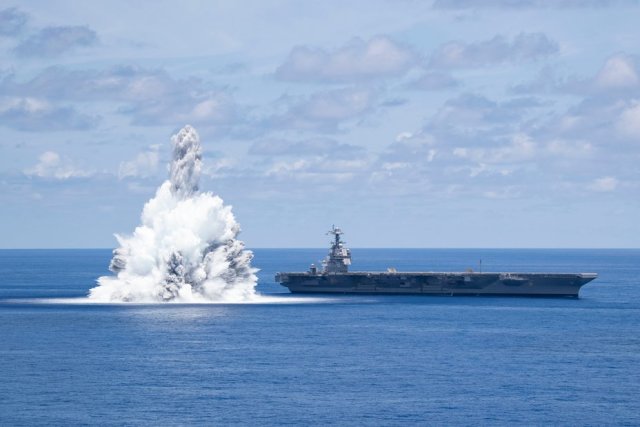The newest American aircraft carrier is proving its combat readiness. Yesterday, July 19, the portal defensenews.com he reported that the US Navy conducted the second stage of the Full Ship Shock Trials (FSST) tests for the USS Gerald R. Ford.
"The second stage of the tests was planned for July 1, but technical problems with the test equipment on board one of the auxiliary vessels prevented this. The second explosion took place on July 16. Despite the delay, the tests are proceeding within the previously designated schedule, " the press service of the US Navy reported.

Each of the repeated underwater explosions of the FSST tests is carried out closer to the ship
Image source: defensenews.com
The US Navy tests its ships for strength with an explosion. For these purposes, the FSST (Full Scale Shock Trials) program has been developed, according to which the ship is subjected to a series of three explosions. According to the authors of the testing, this should confirm that the ship is ready for combat operations and will be able to "survive" if hit by a missile or bomb attack. At a distance of less than 100 m from the ship, 4.5 tons of explosives are detonated under water (the exact method of testing FSST is classified). After detonating the charge, a special team collects data from hundreds of sensors fixed at different points of the ship and determines the level of damage.
Initially, the US Navy command proposed to subject the John F. Kennedy, the second Gerald R. Ford-type aircraft carrier, to a" shock test". According to the military, such a decision would speed up the deployment of the ship and strengthen the capabilities of the fleet. But later this idea was abandoned. According to an unofficial version, one of the reasons for this decision is the development by China of new DF-21D anti-ship missiles.
The USS Gerald R. Ford is the first in a series of ten ships of the same type. The new aircraft carriers will replace the Nimitz-type ships in service, which have been in operation since 1975. Gerald R. Ford is the third generation of nuclear-powered aircraft carriers serving in the US Navy. The first of them was the Enterprise type, but due to the high cost of the ship, the program was limited to a single copy that served from 1962 to 2012 (a total of six aircraft carriers were planned to be built).
